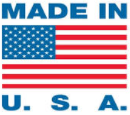The Art and Utility of Profile Extrusions: Fabrication and Applications
Created at : Aug 25, 2023
In the realm of modern manufacturing, profile extrusions stand out as a versatile and efficient method for creating a wide range of shapes used in various industries.
Unveiling the Profile Extrusion Process
Profile extrusion is a manufacturing process that involves transforming raw materials into complex, continuous cross-sectional shapes. The process is characterized by pushing a material through a specially designed die, creating a consistent profile. Let's delve into the stages of profile extrusion:
1. Material Selection: The first step is selecting the appropriate raw material. Common materials include metals like aluminum, steel, and brass, as well as polymers like PVC, HDPE, and even advanced materials like carbon fiber composites. The material's properties are crucial in determining its suitability for the intended application.
2. Extrusion Machinery: Extrusion machines, known as extruders, consist of a barrel and a screw mechanism. The material is introduced into the barrel, where it is gradually heated and pushed forward by the rotating screw.
3. Heating and Melting: The material within the barrel is subjected to controlled heating. As the temperature increases, the material softens and eventually melts into a viscous state. The extruder's screw assists in uniformly melting the material.
4. Die Design and Formation: The heart of the process is the extrusion die. This precisely engineered component defines the shape and dimensions of the final profile. The molten material is forced through the die's opening, which imparts the desired cross-sectional shape.
5. Cooling and Solidification: As the material exits the die, it encounters a cooling process. Cooling can be achieved through water baths, air cooling, or even specialized cooling chambers. This rapid cooling solidifies the molten material into its new shape.
6. Sizing and Cutting: The extruded material is carefully sized and cut into the desired lengths. Sophisticated machinery ensures precise dimensions, maintaining the integrity of the extrusion's profile.
Applications of Profile Extrusions
The versatility of profile extrusions makes them indispensable across a multitude of industries:
1. Construction and Architecture: Custom aluminum extrusions find their place in creating window frames, door profiles, curtain walls, and structural components. Their lightweight yet sturdy nature and corrosion resistance make them ideal for architectural applications.
2. Automotive Industry: Extruded profiles are extensively used in the automotive sector for manufacturing window trims, door seals, bumpers, and even engine components. Their design adaptability and material strength are valuable assets in vehicle construction.
3. Electronics: The electronics industry benefits from profile extrusions in the form of heat sinks, enclosures, and housing components. The ability to customize the shape and efficiently manage heat dissipation makes them indispensable in electronic device design.
4. Consumer Goods: Furniture, shelving systems, and retail displays often incorporate extruded profiles to achieve unique designs and functional features.
5. Packaging: Customized extruded profiles play a role in packaging solutions, providing durable and precisely engineered designs for bottles, containers, and other packaging formats.
6. Renewable Energy: Solar panel frames and mounting systems are frequently constructed using profile extrusions due to their lightweight yet robust nature, which aids in efficient solar panel installation.
7. Aerospace: The aerospace industry benefits from profile extrusions in crafting lightweight yet structurally sound components for aircraft interiors, frames, and specialized equipment.
Conclusion
Profile extrusion is a remarkable manufacturing process that seamlessly blends science, engineering, and creativity. Its ability to transform raw materials into intricate shapes with consistent precision has led to its widespread use across industries. From enhancing the aesthetics of architectural structures to improving the efficiency of electronic devices, profile extrusions continue to shape the way we design and construct products in today's ever-evolving world.

